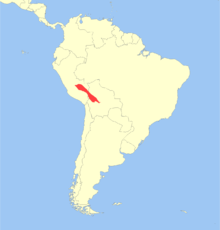Dwarf brocket
| Dwarf brocket | |
|---|---|
| Scientific classification | |
| Domain: | Eukaryota |
| Kingdom: | Animalia |
| Phylum: | Chordata |
| Class: | Mammalia |
| Order: | Artiodactyla |
| Family: | Cervidae |
| Subfamily: | Capreolinae |
| Genus: | Mazama |
| Species: | M. chunyi
|
| Binomial name | |
| Mazama chunyi Hershkovitz, 1959
| |

| |
The dwarf brocket (Mazama chunyi), or chunyi, is a small species of deer[2] native to the Andean highlands in western Bolivia and southeastern Peru, where it is found in forest and páramo. Its pelage is reddish-brown with dark grey foreparts and neck. The underparts are lighter brown, and the muzzle short and thick. It weighs around 11 kg.[3]
A little-studied species of brocket deer, the IUCN considers the dwarf brocket as Vulnerable.[1] Research has occurred in the forests of Bolivia, expanding known localities and modelling geographic distribution; while as much as 40% of the habitat was degraded or fragmented, the rest showed good conservation. This led to the recommendation of treating it as Vulnerable.[4]
References
- ^ a b Rumiz, D.I.; Barrio, J. (2016). "Mazama chunyi". IUCN Red List of Threatened Species. 2016: e.T12913A22165860. doi:10.2305/IUCN.UK.2016-2.RLTS.T12913A22165860.en. Retrieved 12 November 2021.
- ^ Grubb, P. (2005). "Order Artiodactyla". In Wilson, D.E.; Reeder, D.M (eds.). Mammal Species of the World: A Taxonomic and Geographic Reference (3rd ed.). Johns Hopkins University Press. pp. 637–722. ISBN 978-0-8018-8221-0. OCLC 62265494.
- ^ Trolle, Mogens; Louise H. Emmons. "A record of a dwarf brocket from lowland Madre de Dios, Peru". Amazon Conservation Association. Archived from the original on 2004-08-25. Retrieved 2007-06-08.
- ^ Rumiz, D. I.; E. Pardo; C.F. Eulert; R. Arispe; R.B. Wallace; H. Gómez; B. Ríos-Uzeda (April 2007). "New records and a status assessment of a rare dwarf brocket deer from the montane forests of Bolivia". Journal of Zoology. 271 (4): 428–436. doi:10.1111/j.1469-7998.2006.00226.x.

